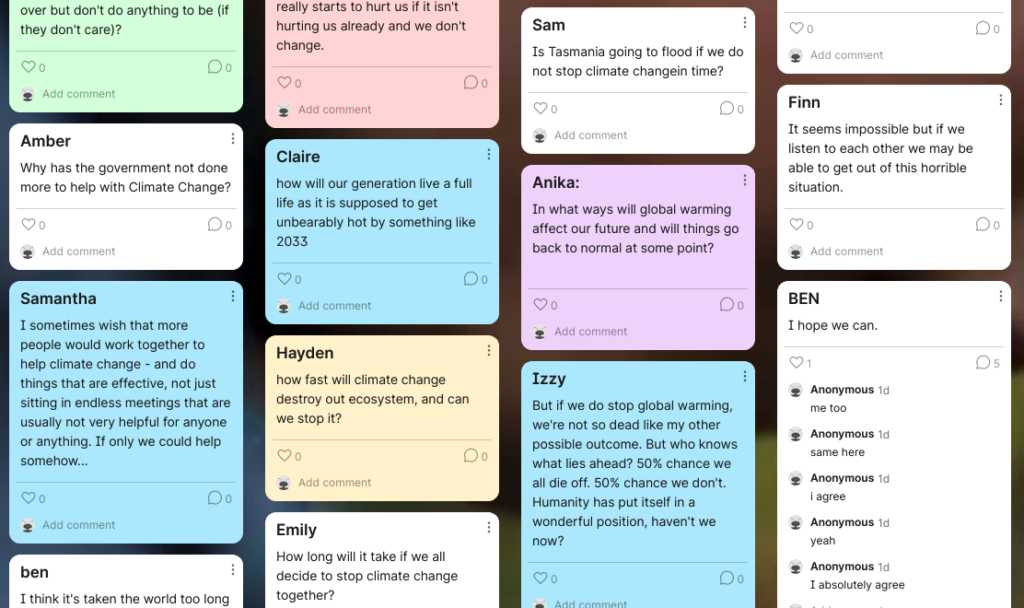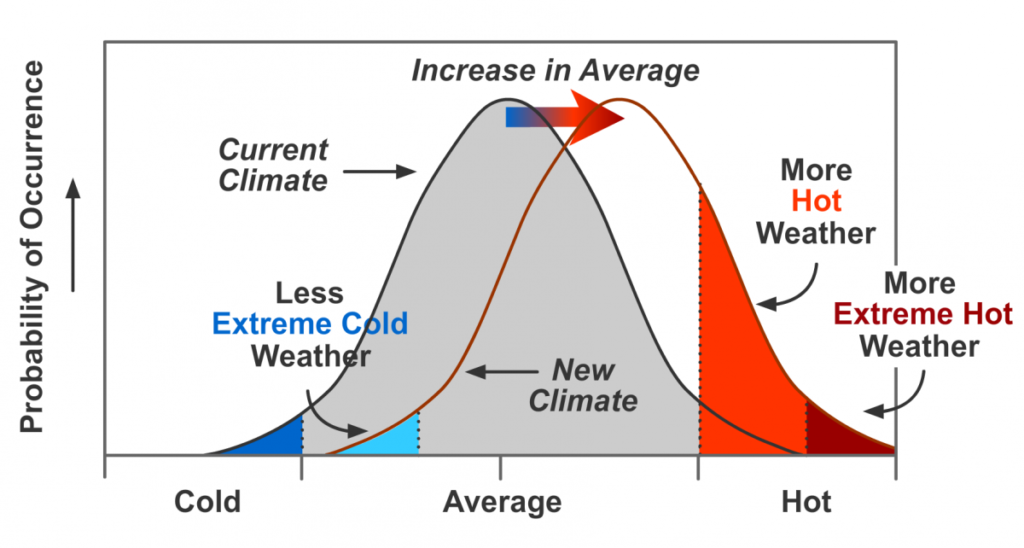Department of Education Online Extension Program - Action Pact and Socrates Café

Our Questions
Climate change is already affecting ecosystems in our oceans and on land, all around the world. In many cases these effects are negative ones, such as the impact of ocean warming and acidification on coral reefs, or the effects of changing ocean temperatures on the loss of giant kelp forests off the east coast of Tasmania. Loss of key species like kelp, or groups of species like corals, can have flow-on effects to many other species that depend on them for habitat or food, and so can quite quickly cause ecosystems to change completely.
However, not all species or ecosystems are negatively affected by climate change. There are some winners as well as losers. One of the most noticeable ecological effects of climate change that we are seeing in the oceans and on land is large-scale movement of species as their habitats warm and they move (if they can) to follow the location of their preferred habitat. But of course not all species can move. Some might have limits to how far they can move (for example up a mountain), or they may not be able to move fast enough to keep up with warming temperatures.
There are lots of things that we can do to help species and ecosystems adapt to the effects of climate change. Because the Earth’s climate is changing so quickly we may need to help some species by speeding up their rate of evolution. We can reduce the number of other human impacts – like pollution or fishing – so that species and ecosystems are less vulnerable to the effects of climate change. We may be able to use technological interventions to help some species or ecosystems adapt, such as relocating them or providing them with artificial substrates.
Every country must design its own plan for mitigating and adapting to climate change because every country has different industries, energy profiles, and geography. For example, some countries have been able to commit to net-zero carbon emissions for their energy sector because they rely on nuclear power.
That said, there are examples from many countries of how Australia can transition away from high-emissions policies. The UK has committed to the largest emissions reductions. It is committing to a 68% reduction by 2030, 78% by 2035 and net-zero by 2050. This is significant because these commitments clearly require strong action now, not just a commitment to net-zero by 2050 all the action being put off until 2049! The EU has committed to emissions cuts of 55%, on 1990 levels and has made these targets legally binding. The United States has also significantly increased its climate ambition. These are the commitments that Australia will be pressured to strive for at the November COP.
There are so many potential examples of good practice. Many countries, including Belgium and the UK, have either ended or committed to ending coal-fired power. Denmark has some of the best renewable energy policies. Sweden is the largest per-capita contributor to the Green Climate Fund (to help developing countries with the costs of adaptation and mitigation). The United States offers significant tax incentives to encourage the uptake of electric vehicles and states like California have strong car emissions standards.
Finally, it’s worth pointing out that Australia has much that it can share with the world. Our researchers are world leaders on many aspects of climate change science and adaptation, and we have already started trialling carbon-negative agricultural techniques. We can also learn from our own past. Australia did have an excellent framework in place when Julia Gillard introduced the carbon price back in 2011. In the year that it operated it already started to bring down emissions because emitters realised it was going to be cheaper in the long term to transition than to keep paying to be able to emit. It was repealed by the Abbott Government and emissions have been rising ever since.
This is a great question! The recent IPCC report (from the Intergovernmental Panel on Climate Change – which includes experts from Tasmania!) tells us that collectively, we will need to act fast to make changes to limit global warming to 1.5°C in the next decades. If we can manage to greatly reduce global greenhouse gas emissions (such as carbon dioxide, or CO2, by driving less or by burning less fossil fuels like coal) we can limit climate change. Most likely, it could take 20-30 years to see global temperatures become stable.
To help have quick and large impact, we need to take action at individual, collective and systematic levels:
At an individual level, each of us can do things like:
- Aim to take the bus, or walk or ride your bike to school more instead of travelling by car.
- Eat more vegetables and less meat (maybe even encourage your family and friends to have ‘meat free Mondays’?!) Plant-based foods generally produce fewer greenhouse gas emissions and they also require less energy, land, and water usage. Or try to eat more local food that hasn’t need to come from far away, which is a fun way to try new food and get to know Tasmanian food producers at your local farmer’s market!
- Speak up! Tell your friends and family about climate change and the small changes each of us can do to make a difference - remembering that we all have different abilities to make these changes, big and small.
But remember that this will require more than just individual action. And whilst reducing emissions is a good thing, if we completely stopped emitting CO2 tomorrow, there wouldn’t be enough energy to generate electricity, or for us be able to travel and bring people and food to places around the world. That means we need to change our systems (like the ways we transport things, and make electricity) so that we can live without needing to use fossil fuels.
As you’ve outlined in your question, we need to work together to achieve these kinds of system changes to take action on climate. Using our voices to demand change is also a really important thing we can do. Find out more things we can all do on the 'What can I do?' page.
How hot it will get by 2033 depends on mitigation actions taken today. If greenhouse gas emissions are reduced quickly and net-zero CO2 emissions achieved, there will not be as much warming as there will be if these actions are not taken.
In Tasmania it is predicted to average between 1.05 and 1.27 degrees Celsius warmer than pre-industrial levels in the year 2033. Now this isn’t as high as the predictions for global temperature increase, but that’s because there are significant local variations in temperature increases. Tasmania is an island – so the ocean helps keep us a bit cooler than other places.
There will be more days that are unbearably hot – because the increasing average temperature means that extreme temperatures will increase too, creating more hot and extremely hot weather.

While by 2033 it will not be unbearably hot in Tasmania very often, there will still places in the world where this temperature change has a really big impact. Climate scientists predict that extreme weather are heatwaves are going to increase and get more extreme. Urban air temperature is also often higher than in rural environments, due to heat generated by traffic and industrial activity, as well as the spread of heat-trapping concrete buildings that have steadily replaced plant life. Heat waves impact vulnerable people the greatest – children, the elderly, those with existing health conditions, people who are experiencing homelessness and people in financial difficulties. It is important that we are looking after the most vulnerable in our communities and in the global community.
There are things we can do. For example, urban greening! More information about urban greening can be found here: https://theconversation.com/urban-greening-can-save-species-cool-warming-cities-and-make-us-happy-116000
Your generation already are and will continue to live with the impacts of climate change as you get older. And this can feel frustrating and scary as you look towards your and our planet’s futures. Lifestyles may change, but that doesn’t mean you can’t live a full life. If you’re needing some help with what to do with these feelings have a look at our page on the Curious Climate website.
You can have a look at an interactive map that shows predicted warming here: https://www.carbonbrief.org/mapped-how-every-part-of-the-world-has-warmed-and-could-continue-to-warm
How will Tasmania stop the waters rising? You might not like to read this, but sea level rise will continue for hundreds maybe thousands of years, even if the world stops climate heating emissions in their tracks today. This is because the ocean mass is so big, and it changes slowly. BUT, what the world does now to limit global warming will have a great impact on how fast sea level rises and by how much.
Since Tasmania produces electricity by renewable fossil fuel-free hydropower, it won’t be difficult for us as a state to achieve net zero by 2030. So how can Tasmania further help with limiting global climate change and the impacts of sea level rise? In our own backyard, Tasmania can be more prepared in understanding the risks and helping our communities be resilient to coastal flooding and erosion. Tasmania can also work towards being carbon positive so that we capture carbon already in the atmosphere.
Beyond our island, Tasmania can keep improving agriculture and aquaculture practices to feed the world more sustainably. Tasmania can be a leader in adapting to sea level rise - some of our scientists are developing coastal protection methods that also boost marine biodiversity. Tasmania can support our Pacific nations friends who are losing their island homes to sea level rise, by sharing knowledge and resources and welcoming those who must leave. We all need to keep talking about climate change and looking for opportunities to make whatever positive difference we can.
Thanks to the students in the Action Pact and Socrates Café extension program for your great question.













